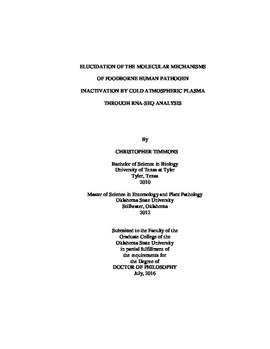| dc.description.abstract | Foodborne human illness caused by pathogenic bacteria is a significant health and economic burden worldwide. Efficient food decontamination methods that do not alter food quality can greatly alleviate this burden. Cold atmospheric plasma, which is ionized gas generated at room temperature and atmospheric pressure, is an emerging technology that offers a dry, non-thermal, rapid decontamination process with minimal damage to food products. Surface dielectric barrier discharge (SDBD) is an open-air cold plasma generation technology with low power requirements that is more flexible, portable, and scalable than current cold plasma generation methods. Although the bactericidal effects of cold plasma are well documented, the specific mechanism by which bacterial inactivation occurs is not well understood. In this research, a novel SDBD design was used to evaluate 1) induced airflow dynamics and bacterial foodborne pathogen inactivation, 2) morphological and transcriptomic responses of Salmonella to cold plasma treatment, and 3) the potential for bacterial resistance development to cold plasma. The novel SDBD actuator designs were found to induce a localized airflow that pushes reactive species to distant surfaces, allowing inactivation of common bacterial pathogens on biotic and abiotic surfaces. The transcriptomic response of surviving Salmonella cells to SDBD revealed a general decrease in stress responses thought to be a result of rapid lipid peroxidation, cytosolic leakage, and cell lysis, as revealed by transmission electron microscopy and RNA sequencing. In contrast, DNA and protein damage by plasma-produced RONS were found to have a minor role in SDBD-induced inactivation of Salmonella. Furthermore, after treating a population of plasma-injured cells in succession, no significant differences in bacterial inactivation rates or differential gene expression were identified that could potentially lead to resistance development. These results confirm that the novel SDBD cold plasma actuators have potential applications in food surface decontamination and that the physical process of lipid peroxidation is a major cause of bacterial inactivation. Following further optimization and delineation of treatment parameters and plasma generation characteristics of the novel SDBD actuators, cold plasma will be a viable alternative to help alleviate the global burden of foodborne illness and continued antibiotic resistance development among bacterial pathogens. | |
